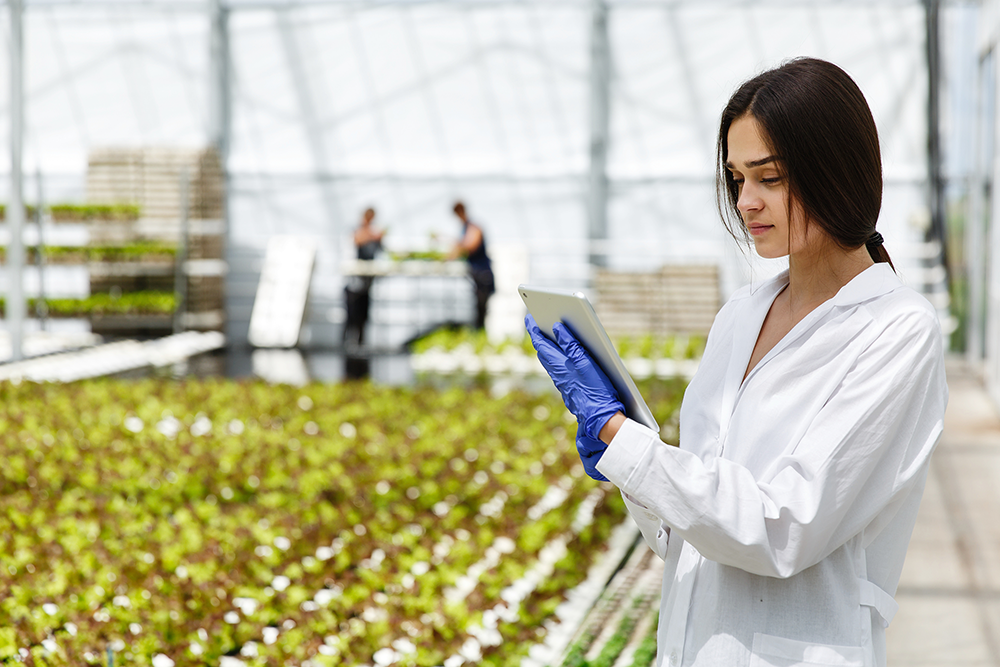Feeding The World Sustainably: The Power of Tech in the Food Industry

Feeding The World Sustainably: The Power of Tech in the Food Industry
November 17, 2023
The global population is on the rise, and with it, the demand for food is increasing at an unprecedented rate. To meet this growing request, the agriculture and food industry must find ways to increase production while also mitigating its environmental impact. This is where technology enters the game as a major pawn in shaping the future of the food industry and ensuring sustainability.
A Global Food Crisis: What’s Going On?
According to the United Nations, by 2050, the world’s population is expected to reach 9.7 billion people, so, we will need to produce 60% more food to feed the global population.
However, while the need for more food production arises, there is also a concerning problem regarding food sustainability. Agriculture is one of the main sources of food worldwide, and it’s also at the heart of the solution to the sustainability issue. If we improve agricultural systems, we can improve the lives and health of people, as well as produce healthier ecosystems.
How? With a little hand from technology. Green technologies, biotech advances, and artificial intelligence could help tame agricultural emissions and waste, promoting sustainability. Let’s understand in what way.
How is Technology Improving the Food Industry?
Tech might not be the first thing that comes to mind when you think about food. However, the food industry is undergoing a rapid transformation, driven by advancements in technology that are impacting the entire food supply chain.
Precision Agriculture
Precision agriculture is one of the most significant innovations in modern farming. This approach leverages technology, such as GPS-guided tractors, drones, and sensors, to optimise crop yields while minimizing resource usage. Farmers can monitor soil conditions, weather patterns, and plant health in real-time, allowing for more efficient irrigation, fertilization, and pest control. By reducing waste and enhancing productivity, precision agriculture helps conserve water, reduce chemical usage, and lower greenhouse gas emissions.
Vertical Farming
Traditional agriculture requires vast expanses of land, which often leads to deforestation, habitat destruction, and soil degradation. Vertical farming, on the other hand, enables the cultivation of crops in vertically stacked layers, typically in controlled indoor environments.
This technology allows for year-round production, reduces the need for pesticides, and minimizes water usage. Additionally, vertical farms can be located in urban areas, shortening the distance food travels from farm to table, thus reducing transportation emissions.
Plant-Based and Cellular Agriculture
The popularity of plant-based and cellular agriculture is on the rise. Plant-based products, like meat and dairy alternatives, are developed using ingredients such as pea protein, soy, and fungi. Cellular agriculture involves the cultivation of animal cells to create real meat without the need for traditional livestock farming.
These innovations address the environmental and ethical concerns associated with conventional meat production, such as land use, water consumption, and animal welfare. Technology-driven advancements in these areas are helping to reduce the environmental footprint of the food industry while satisfying the growing demand for protein.
Supply Chain Efficiency
Efficient supply chains are crucial for reducing food waste and ensuring that food reaches consumers in a timely manner. Technology solutions like blockchain and the Internet of Things (IoT) enable improved traceability and transparency in the supply chain. This ensures that food safety standards are met and helps prevent spoilage, contamination, and fraud. It also allows for better inventory management and reduces the carbon footprint of food transportation by optimising routes and reducing delays.
Food Apps and Services
Technology has also transformed the way consumers interact with food. Food delivery apps, meal-kit services, and recipe apps are making it easier for people to access and prepare meals at home, reducing food waste and the carbon footprint of dining out. These platforms can also help users make healthier and more sustainable food choices through features like nutritional information and recipe suggestions.
AI and Machine Learning
Artificial intelligence (AI) and machine learning are driving advancements in data analysis and prediction, which can greatly benefit the food industry. These technologies are used to optimise crop yields, predict foodborne disease outbreaks, and even improve the flavor of foods by analyzing consumer preferences. AI can help farmers make data-driven decisions and reduce waste, while machine learning algorithms can be used to enhance food safety and quality control.
Food Recycling and Waste Reduction
In the quest for sustainability, technology is helping to address the issue of food waste. Apps and services are being developed to connect consumers with surplus food from restaurants and grocery stores, ensuring that edible but unsold food is not discarded. Additionally, innovations like anaerobic digestion and food recycling programs can turn food waste into biogas or compost, reducing the environmental impact of food disposal.
As the global population continues to grow, the challenge of feeding the world sustainably becomes more pressing. Thus, the integration of technology in the food industry is not only a solution but a pathway to a more environmentally friendly, efficient, and ethical food system.